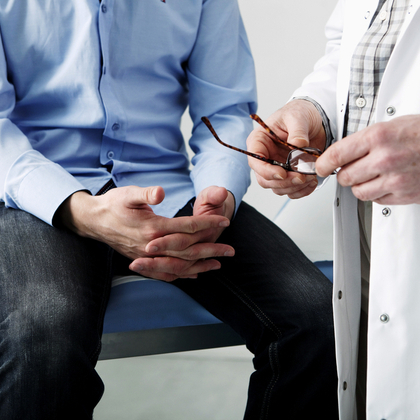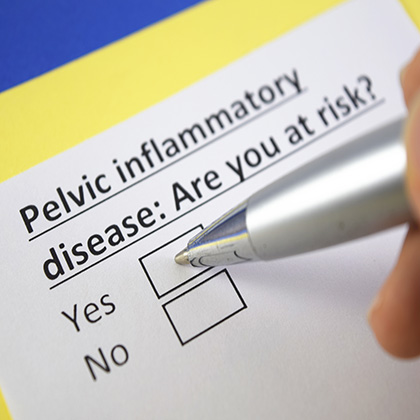Bladder weakness – or urinary incontinence – affects around 50 million people in the developed world at some point or other (i). In fact, according to the NHS, between three and six million people in this country have some degree of incontinence problems.
Bladder problems can affect men, women, the young and the old. As many as one in five women aged 40 or older is thought to have urinary incontinence to some extent or other (iii), with studies suggesting that between three and 11 per cent of men are affected too (iv). Yet while it can happen at any age, you’re more likely to develop urinary incontinence as you get older (iii). The good news, however, is that while many people think incontinence is an inevitable part of ageing, experts believe that in about 80 per cent of cases it can be cured or improved (v).
Two most common types of urinary incontinence are called stress incontinence and urge incontinence:
Stress incontinence
Triggered by exercise, coughing, sneezing and laughing, this is the most common type of incontinence in women (vi). Stress incontinence can happen when your pelvic floor muscles and/or your urethra – the tube that carries urine out of your body from your bladder – become weakened or damaged.
Urge incontinence
If you experience a sudden and intense urge to pass urine or if you need to urinate frequently, including during the night, you may have urge incontinence. This can be caused by the muscles in the walls of your bladder – called the detrusor muscles – contracting more often than normal.
Other, less common types of bladder weakness include the following:
Overflow incontinence
Also called chronic urinary retention, overflow incontinence is when you cannot empty your bladder completely.
Overactive bladder syndrome (OAB)
Like urge incontinence, OAB makes you want to go to the loo suddenly and frequently – though you may not lose control of your bladder.
Nocturia
If you need to urinate more than a couple of times during the night, the condition is called nocturia. This is often associated with getting older, but may also be caused by a medical problem.
Mixed incontinence
It’s also fairly common to be affected by more than one type of urinary incontinence.
What causes bladder weakness?
There are several reasons why someone may have urinary incontinence. Being pregnant or very overweight can trigger stress incontinence, while having a urinary tract infection, being constipated and drinking too much alcohol or caffeine are some of the possible causes of urge incontinence. Some people with neurological conditions – that is, conditions that affect the brain and spinal cord, such as multiple sclerosis or Parkinson’s disease – may also develop urge incontinence.
Certain medicines may affect your bladder too, including diuretics, some antidepressants, hormone replacement therapy (HRT), sedatives and ACE inhibitors.
Who’s at risk?
Whether you’re male or female, the following may increase your risk of having bladder weakness:
-
Your age (urinary incontinence becomes more common as you get older). Discover a number of natural ways to support ageing in our article.
-
Your family history (especially if stress incontinence runs in the family)
-
A disability such as a condition that affects your brain or spinal cord
-
Having lower urinary tract symptoms (LUTS) such as having problems with storing or passing urine
-
Being pregnant, having a vaginal delivery and having a baby with a heavier birth weight.
-
Prostate enlargement (benign prostatic hyperplasia) and prostate gland removal (prostatectomy) in men may also increase the risk of urinary incontinence.
-
Cognitive impairment.
Bladder weakness: how to help yourself
If you’re experiencing bladder weakness, there are several lifestyle changes you can make that may help relieve your symptoms:
Maintain a healthy weight
Being overweight can put extra pressure on your bladder as well as your pelvic floor muscles, which help keep your bladder strong. If you’re overweight and have a bladder weakness problem, you may well find that losing the excess weight is all you need to do to relieve your symptoms.
Quit smoking
If you smoke, you may cough more than non-smokers. And that can put a strain on your pelvic floor muscles. Experts also believe nicotine may irritate the muscles in your bladder (vii). If you’re struggling with giving up, there are several quit smoking products that may help, including gum, lozenges and patches.
Drink plenty of water
It may be tempting to drink less water if you are affected by bladder weakness. However, not drinking enough could be the reason behind your problem. That’s because the less you drink, the less your bladder may be able to hold. Aim for six to eight glasses of water a day to keep your bladder healthy.
Cut down on caffeine and alcohol
Unlike water, alcohol is a diuretic, which means it affects your kidneys and makes you urinate more than you take in. So when you drink, you may need to go to the toilet much more often than usual. Caffeine is also a bladder irritant that can make bladder weakness worse. Ideally, stick to official alcohol intake recommendations (14 units of alcohol or less each week spread over at least three days), and avoid drinking too much tea, coffee and fizzy drinks (or switch to decaffeinated versions).
Train your bladder
If you see your GP for a problem with urge incontinence, one of the first treatments you may be offered is bladder training. This involves learning techniques that could help you go for longer without feeling the need to urinate. For instance, try avoid emptying your bladder unless you really need to, as going to the toilet too frequently may reduce the amount your bladder can hold. For more advice about bladder training, speak to your GP.
Tackle constipation
Being constipated can put a strain on your pelvic floor muscles, which can trigger bladder weakness. Eating more fibre and taking more exercise may help to keep you regular.
Swap jogging for Pilates
High-impact exercise such as jogging or aerobics can put stress on your pelvic floor muscles and trigger leaks. But strengthening your pelvic floor muscles can boost your bladder function. One of the best types of exercise that focuses on working the pelvic floor muscles is Pilates. Find out if there’s a class in your area by asking at your local gym or leisure centre.
Take a bladder-friendly supplement
Several natural remedies have been used traditionally to treat incontinence. And while there aren’t any scientific studies to confirm the effectiveness of these remedies, some people believe supplements may help. One such supplement is vitamin C, which some think may help reduce inflammation in an overactive bladder (however, one study suggests women who take high doses of vitamin C – more than 500mg – are more likely to report symptoms of overactive bladder than those who take less than 50mg) (viii).
How to exercise your pelvic floor
If you’re affected by urinary incontinence, there are exercises you can do at home – or indeed anywhere – to help you control your bladder.
These exercises help to strengthen your pelvic floor muscles (the muscles that control and support the bladder), which can be weakened by a number of things including pregnancy, childbirth, being overweight, age, certain medications and surgery. Also called Kegel exercises, pelvic floor exercises may help if you tend to leak a few drops of urine when you laugh, sneeze or cough (stress incontinence), or if you have strong, sudden urges to urinate (urge incontinence). You only have to spend a few minutes doing them three or more times a day for them to be effective. And the best part is, working your pelvic floor muscles is so discreet, nobody – not even someone sitting next to you – will know you’re doing it.
First, here’s how to locate your pelvic floor muscles. Sit comfortably and imagine you’re passing urine. Then imagine you’re stopping the flow. The muscles you’ve just used are your pelvic floor muscles. Avoid using your stomach, buttock or thigh muscles, and only those muscles that control the flow or urine. Once you can locate your pelvic floor muscles easily, there are several exercises you can do. You can do them at almost any time and anywhere, such as while you’re in the car, while watching TV, sitting at your desk, lying in bed or walking to the shops. You could also try getting into the habit of doing them while you’re brushing your teeth every morning and evening, or while waiting for the kettle to boil.
Here are a couple to get you started:
-
Go slow
Slowly tighten and pull up your pelvic floor muscles as hard as you can and for as long as you can, then rest for four seconds and repeat. Build up gradually until you can do 10 slow contractions at a time, holding them for 10 seconds each with rests of four seconds in between. -
Quick contractions
To get your pelvic floor muscles into shape so that they can react quickly to sudden stresses, such as coughing, laughing or exercising, practice drawing in the muscles quickly, holding them for just a second before relaxing. Build up to 10 quick contractions in succession.
Bladder weakness and pregnancy
Bladder weakness during pregnancy is common. That’s because pregnancy puts a lot of stress on the bladder, causing stress incontinence. Not only does a growing uterus and foetus put extra pressure on your bladder, but the amount of blood in your body increases when you’re pregnant too, leading to more fluid being passed through your bladder. And because the fluid that settles in your legs and feet during the day gets back into your bloodstream when you lie down in bed, you may find yourself needing to go to the toilet more often during the night.
Incontinence may also happen in pregnancy because the bladder or the urethra (neck of the bladder) has moved, because nerves in your bladder have been damaged, or because you may experience muscle spasms that affect the bladder sphincter – a muscular valve that normally keeps urine in the bladder.
Once your baby has been born you may also need to urinate more frequently for a few days as your body tries to dispose of all that extra fluid it retained while you were pregnant. This, however, should all settle down and you should be urinating normally again within seven to 10 days. Another way pregnancy and childbirth can affect your bladder is they may weaken your pelvic floor muscles. Having a forceps delivery can also stretch the pelvic floor muscles, which can lead to bladder weakness. Understanding the impact that pregnancy can have upon your body can be a good way to prepare for these changes.
What can you do?
If you have urinary incontinence during and after pregnancy, try to find out when you tend to need to urinate and when you tend to leak. By understanding this pattern, you may be able to avoid accidents by making sure you go to the toilet just before you would normally need to urinate or have a leak. Bladder training may also help. For instance, try to wait a little longer each time you need to empty your bladder. Or whenever you get the urge to go to the toilet, try to postpone it for a few minutes and build up until you can wait for longer. It’s also a really good idea to get into the habit of practicing pelvic floor exercises during and after your pregnancy to keep the muscles that control your bladder from weakening. However, if you’re still experiencing bladder weakness six or more weeks after giving birth, discuss it with your doctor.
For more information on a number of common health conditions and concerns, visit our health library. There you’ll find a range of helpful advice and articles.
References:
-
Available online: https://bladderhealthuk.org/bladder-conditions/continence-support
-
Available online: https://www.nhsinform.scot/illnesses-and-conditions/kidneys-bladder-and-prostate/urinary-incontinence
-
Available online: https://patient.info/kidney-urinary-tract/urinary-incontinence-leaflet
-
Nitti VW . The Prevalence of Urinary Incontinence. Rev Urol. 2001;3(Suppl):S2-S6.Available online: https://www.ncbi.nlm.nih.gov/pmc/articles/PMC1476070/
-
Available online: https://bladderhealthuk.org/bladder-conditions/continence-support
-
Available online: https://patient.info/womens-health/lower-urinary-tract-symptoms-in-women-luts/stress-incontinence
-
Wyman. JF, Burgio. KL, Newman. DK. Practical aspects of lifestyle modifications and behavioural interventions in the treatment of overactive bladder and urgency urinary incontinence. Int J Clin Pract. 2009 Aug63(8):1177-1191.Available online: https://www.ncbi.nlm.nih.gov/pmc/articles/PMC2734927/
-
Maserejian N et al. Intakes of Vitamin and Minerals in Relation to Urinary Incontinence, Voiding, and Storage Symptoms in Women: A Cross-Sectional Analysis from the Boston Area Community Health Survey.European Urology 2011 June, volume 59, issue 6, 1039-1047. Available online: https://pubmed.ncbi.nlm.nih.gov/21444148-intakes-of-vitamins-and-minerals-in-relation-to-urinary-incontinence-voiding-and-storage-symptoms-in-women-a-cross-sectional-analysis-from-the-boston-area-community-health-survey/
Related Posts
Disclaimer: The information presented by Nature's Best is for informational purposes only. It is based on scientific studies (human, animal, or in vitro), clinical experience, or traditional usage as cited in each article. The results reported may not necessarily occur in all individuals. Self-treatment is not recommended for life-threatening conditions that require medical treatment under a doctor's care. For many of the conditions discussed, treatment with prescription or over the counter medication is also available. Consult your doctor, practitioner, and/or pharmacist for any health problem and before using any supplements or before making any changes in prescribed medications.

Christine
Christine Morgan has been a freelance health and wellbeing journalist for almost 20 years, having written for numerous publications including the Daily Mirror, S Magazine, Top Sante, Healthy, Woman & Home, Zest, Allergy, Healthy Times and Pregnancy & Birth; she has also edited several titles such as Women’ Health, Shine’s Real Health & Beauty and All About Health.
View More



